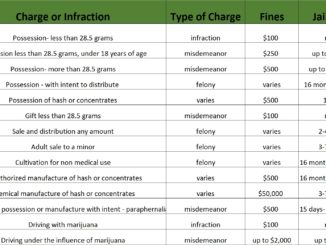
A very influential factor regarding the legalization of marijuana, is the cost implications of maintaining cannabis prohibition to the federal and provincial governments, and in turn the average Canadian taxpayer. According to the Auditor General of Canada, it is projected that approximately $ 450 million was spent on drug control, enforcement, and education in the year 2000.
Since ¾ of drug offences are marijuana related, the majority of the $ 450 million spent across Canada was due to cannabis prohibition laws. This spending also does not include funding for marijuana related court hearings, or incarcerations, as over 300 000 people are arrested for simple marijuana possession every year (Cohen et al. 2). Another issue to consider is that the amount of cannabis users continues to rise across Canada, up from 6.5% in 1989, to 12.2% in 2000 (Nabalamba, 1).
This will only increase the amount of funding the federal government is forced to contribute to drug control and enforcement, further charging the taxpayer. A more cost efficient way to regulate marijuana is to set an age limit through provincial regulation, permitting for adult use of a substance less harmful than both alcohol and tobacco. Otherwise, it is left in the hands of organized crime, with the government continuing to spend millions on its prohibition, and not profiting from its continuous increase in use. In this situation, the regulation of marijuana should not only be allowed, but would financially benefit the country.
Even after thousands of years of people using marijuana to treat a variety of medical conditions, many still believe marijuana is a drug without therapeutic value. Patients undergoing cancer chemotherapy, or AIDS related AZT therapy, found smoking marijuana to be an effective way to curb nausea (Health Canada, "Medical Marijuana"). Often it is more effective than available prescribed medications. "44% of oncologists responding to a questionnaire said they had recommended marijuana to their cancer patients; others said they would recommend it if it were legal" (Zimmer et al. 87). Other uses include control for muscle spasms associated with spinal cord injury / disease, and multiple sclerosis and pain / weight loss associated with cancer, HIV, and arthritis patients.
Cannabis also lessens the frequency of seizures in epilepsy, and controls eye pressure in glaucoma patients (National Institute on Drug Abuse, "Drug Policy Information Sheet"). Although medical marijuana has been approved for use under certain circumstances, it is very difficult, if not impossible, to obtain cannabis for treatment purposes in Ontario. This is because the College of Physicians and Surgeons of Ontario issued a warning in October 2002, cautioning that the "clinical efficacy of the drug has not been entirely established" and to "proceed with caution" when prescribing cannabis (The College of Physicians and Surgeons of Ontario, "Prescribing Medical Marijuana"). Due to this, a physician cannot make a proper declaration of the risks and benefits; Therefore, they can not fully inform the patient of the drugs possible effects.
Fortunately, since the legalization of marijuana for medical use occurred almost 5 years ago, one could assume a proper risk assessment of the drug will soon be completed through Health Canada. Through marijuana's apparent medical usages, it becomes clear that it should be regulated across the country.
The implication of marijuana's prohibition is financially devastating to the federal government. As false social perceptions are the only grounds for this ban to be upheld, and the medical sciences continue to find new usages for cannabis as therapeutic treatment, it remains unfounded to continue its outlaw. Through government enforced regulation, it becomes clear that the benefits of marijuana legalization outweigh the disadvantages.
Proudly WWW.PONIREVO.COM
by Alex Simms



